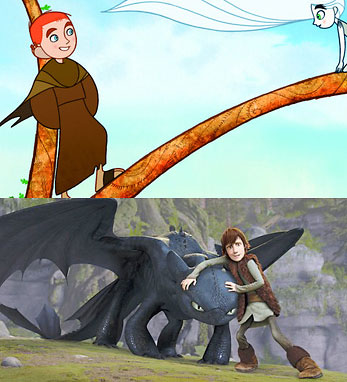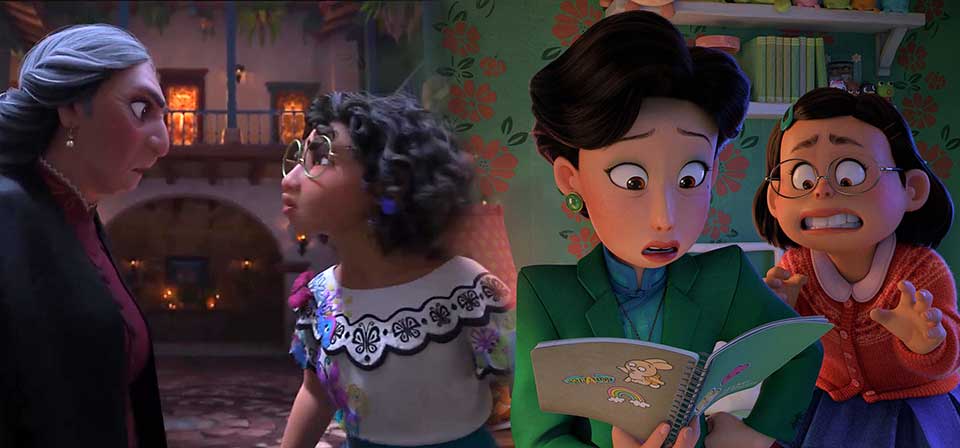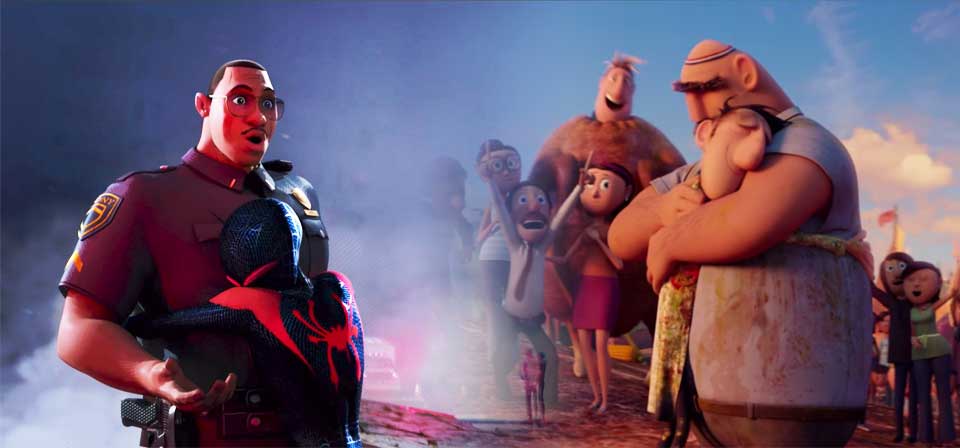Junior Knows Best
In theaters right now are two charming and visually engaging animated films at opposite ends of the budget spectrum, different in many respects but with some interesting overlap as well. One is How to Train Your Dragon, DreamWorks’ big-budget CGI adaptation of a popular children’s book. The other is The Secret of Kells, an Oscar-nominated Irish animated indie made on a comparative shoestring budget, now in limited release.

Top: Brendan and Aisling from The Secret of Kells; Bottom: Hiccup and Toothless from How to Train Your Dragon
Both films are European-set fantasy period pieces, with Vikings and mythological creatures both friendly and decidedly unfriendly. (In How to Train the Vikings are the hero and his people; in The Secret of Kells they’re the bad guys.)
In each film, the protagonist is a young boy living in a rugged, isolated island community in which the undisputed leader is the boy’s own father figure, a stern, towering authoritarian. In How to Train, young Hiccup is the son of the Viking chief, Stoick the Vast; in The Secret of Kells, Brendan lives in an Irish abbey where his uncle Cellach is abbot. (There is no mother figure in either film.)
In each film, the boy is a loner, slight and sensitive, clever, curious and creative. While on his own in the wilderness, he encounters and befriends a mythological creature of whom the father figure would certainly disapprove as a friend. In both films, the friendly creature later ventures into the human community to aid the boy when he is in trouble. It also turns out that the friendly creature lives in fear of another mythological creature: a serpentine, cave-dwelling monster whom the hero must confront and defeat.
For the record, I enjoyed and recommend both films. At the same time, one notable similarity underscores a motif in family entertainment that has long been a concern—a motif that isn’t necessarily a problem in any one instance, but with repetition becomes a troubling pattern over time.
In both films, the young hero’s father figure is an implacably stern authoritarian who seems nothing but disappointed in the hero, and who adamantly refuses to hear what the boy has to say. The boy’s pursuit of discovery causes him to defy the father figure’s wishes, first surreptitiously and finally openly, leading to a confrontation in which the father figure’s disappointment and anger reaches a crescendo. The father figure’s stubbornness endangers the whole community as he leads them into an ill-advised conflict with an enemy whose strength he underestimates. In the end the hero is vindicated, and is ultimately reconciled to the repentant father figure.
The imperious, authoritarian father figure who doesn’t understand is nothing new to family entertainment, from The Sound of Music and Peter Pan to The Little Mermaid and Happy Feet. What is striking about both How to Train and The Secret of Kells, though, is the one-note portrayal of the father figure throughout the entire film, right up to the end. By contrast, The Sound of Music redeems the father figure roughly halfway through the story, while Peter Pan and The Little Mermaid separate the young protagonists from the father for most of the story. (I think the same may be true of Happy Feet, although the specifics of that tale haven’t stayed with me.)
As another point of contrast, consider last year’s Cloudy with a Chance of Meatballs, another film about a clever, creative young loner with a lumbering, uncomprehending father and no mother in an island community, one who like Hiccup is a figure of much mockery and derision. In Cloudy, the hero Flint’s taciturn father doesn’t understand his son’s interests, but here the father’s concerns aren’t necessarily groundless, and the hero isn’t necessarily on the right path. Unlike How to Train and The Secret of Kells, there’s no “Junior Knows Best” dynamic in Cloudy.
Flint’s father isn’t imperious and authoritarian, merely undemonstrative and unable adequately to communicate either his love or his concerns to his son. Finally, one senses a sort of stoic humility about Flint’s father, a possible awareness of his own inadequacies. He isn’t abjectly disappointed in his son, merely concerned for him. I still wish he were more humanized than he is, but he’s a lot better than the implacable father figures in How to Train and The Secret of Kells.
It’s fair to say that each of these films offer their father figures some measure of redemption—Cloudy most touchingly and fondly, How to Train most effectively and heroically, and The Secret of Kells, alas, with little more than pathos. Both How to Train and The Secret of Kells compensate somewhat for their overbearing father figures with a more sympathetic, avuncular authority figure (the tough old trainer Gobber in How to Train, the puckish illuminator Brother Aidan in The Secret of Kells). This tension is more reassuring in How to Train and more problematic in The Secret of Kells, where Brother Aidan is complicit in Brendan’s repeated defiance of Abbot Cellach’s orders, and the themes of disobedience and conflict are given maximum punch.
None of this makes any of these films objectionable in itself, and each film has significant merit in its own right. It’s the pattern more than the individual film that matters most.
Balanced by sympathetic depictions of fatherhood and family life in films like The Incredibles, My Neighbor Totoro, Stuart Little 2, Spy Kids and Finding Nemo, the problemic father figures of How to Train and The Secret of Kells recede in significance. On the other hand, a steady diet of overbearing father figures à la The Little Mermaid and Happy Feet can become a virtual pedagogy in filial contempt and rebellion.
P.S. Read more about father figures in the movies in a short interview I did recently with the Knights of Columbus Fathers For Good website.
Related

Mother knows best: Turning Red, Encanto, and Disney/Pixar’s new overbearing moms
The familiar animation trope of the domineering dad and the (sometimes) supportive mom gets an update in recent films from the Mouse House.

Fathers know best? Phil Lord and Chris Miller’s surprising animated dads
Particularly striking to me, and even moving, is a theme connecting Cloudy With a Chance of Meatballs and Spider-Man: Into the Spider-Verse (though not The Lego Movie): how themes of father–son conflict ubiquitous in other cartoons play out with unexpectedly insightful, consequential fathers.

Junior Knows Best: We need to talk about cartoon parents
I don’t expect animated heroes to have uniformly ideal, harmonious family lives. It’s not realistic — and it doesn’t make for good drama, which needs conflict. The ubiquity of the pattern, though, is striking.
Recent
- Benoit Blanc goes to church: Mysteries and faith in Wake Up Dead Man
- Are there too many Jesus movies?
- Antidote to the digital revolution: Carlo Acutis: Roadmap to Reality
- “Not I, But God”: Interview with Carlo Acutis: Roadmap to Reality director Tim Moriarty
- Gunn’s Superman is silly and sincere, and that’s good. It could be smarter.
Home Video
Copyright © 2000– Steven D. Greydanus. All rights reserved.